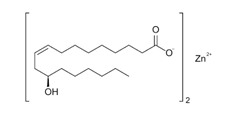INTRODUCTION
Zinc ricinoleate is the zinc salt of ricinoleic acid, a hydroxylated fatty acid derived mainly from castor oil (Ricinus communis). It appears as a white to slightly yellowish powder, waxy solid, or paste, depending on formulation. Its most valuable property is its ability to trap and absorb odor molecules such as amines, sulfides, and short-chain fatty acids, making it an essential ingredient in deodorant and odor-control products.
MANUFACTURE
1.Raw Material Preparation: Ricinoleic acid is separated from castor oil through hydrolysis and purification.
2.Neutralization Reaction: Purified ricinoleic acid is reacted with zinc oxide or zinc salts in a controlled process. The reaction produces zinc ricinoleate as a zinc soap (a metal salt of fatty acid).
3.Finishing & Standardization: The product is dried and processed into either powder, flakes, or pastilles.
| Synonym | (9Z,12R)-12-Hydroxy-octadecenoic acid zinc salt (2:1) |
| CAS no. | 13040-19-2 |
| EINECS no. | 235-911-4 |
| Molecular formula | C36H66O6Zn |
| Molecular weight | 660.29 |
| Structure |  |
APPLICATIONS
| Personal Care & Cosmetics |
| • Deodorants & Antiperspirants – Acts as an odor absorber by binding volatile malodorous compounds. |
| • Foot creams, body lotions, hair care products – Used for odor-control function without irritating skin. |
| • Natural & eco-friendly formulations – Popular in “green” cosmetics because of biodegradability and renewable origin. |
| Household & Industrial Uses |
| • Air fresheners & room sprays – Neutralizes odors from smoking, cooking, or pets. |
| • Textile & laundry care – Incorporated in detergents and fabric conditioners for odor control. |
| • Industrial cleaning products – Used in waste treatment, sanitation, and odor-management formulations. |
| Specialty Applications |
| • Pet care products – Effective in shampoos, sprays, and litter deodorants. |
| • Paints & coatings – Sometimes added for odor-reducing functionality. |
SPECIFICATIONS
| Test | Unit | Specification |
|---|---|---|
| Appearance | – | Creamish to white powder |
| Melting point | ºC | Min 85 |
| Metal content (as Zn) | % | 8.5 – 9.5 |
| Acid value | – | Max 4 |
| Moisture | % | Max 2 |
PACKING
25 kg bag or 50 kg carboy.
STORAGE
Store in cool, dry well-ventilated area.
CERTIFICATION
Zinc ricinoleate offered by ExSyn is registered under EU REACH regulation.
ExSyn offers Zinc ricinoleate on commercial scales and welcomes enquiries. Our exceptional quality and service will make ExSyn your supplier of choice! If you need any additional information or SDS, please contact us.
5-Methyl-3-vinyl-2-oxazolidinone (V-MOX) is a highly reactive monomer valued for its low viscosity, mild odor, and excellent reactivity. It is widely used as a reactive diluent in UV-curable inks and coatings, where it enhances adhesion, produces brighter colors, and improves safety compared to conventional diluents. In addition, V-MOX serves as a key building block in the synthesis of kinetic hydrate inhibitor (KHI) polymers, which are applied in oil and gas production to prevent hydrate blockages in pipelines.
2-(tert-Butyl amino)ethyl methacrylate (TBAEMA) is a functional methacrylate monomer that contains a secondary amine group and a hydrophobic tert-butyl moiety, giving it excellent versatility in pH-responsive and adhesion-enhancing polymer systems.
It is valued in printing ink formulations for its ability to enhance adhesion, flexibility, and surface interaction.
Commonly known as potassium bis(fluorosulfonyl)imide (KFSI), the compound has a three-carbon backbone bearing six fluorine atoms and two sulfonimide (-SO₂F) groups. The molecule’s architecture lends it both high chemical stability and useful reactivity. Because of its excellent ionic conductivity and thermal / electrochemical stability, it finds use in advanced electrolyte formulations—for example in lithium-ion and next-generation batteries, in ionic liquids, and in other electrochemical systems.
Colchicine is a naturally occurring alkaloid obtained primarily from the autumn crocus (Colchicum autumnale) and related species. It has been used in medicine for centuries, especially for the treatment of gout and Familial Mediterranean Fever. In modern medicine, Colchicine is valued also in conditions like pericarditis, Behçet’s disease, and certain dermatological and cardiac disorders.
1-Butylimidazole is a versatile organic heterocyclic compound belonging to the imidazole family, where a butyl group (–CH₂–CH₂–CH₂–CH₃) is attached to the nitrogen atom at the 1-position of the imidazole ring. Its applications span organic synthesis, materials science, and bioactive compound development due to its tunable physicochemical properties and structural versatility.
Atropine sulfate monohydrate is a chemical compound, specifically a salt of atropine and sulfuric acid, with one water molecule (monohydrate) attached. It is commonly used as a medication and in research due to its anticholinergic properties, meaning it blocks the effects of acetylcholine at muscarinic receptors.
4-Aminobenzoic acid, commonly abbreviated as PABA, is an aromatic amine and carboxylic acid compound. It consists of a benzene ring substituted with an amino group (–NH₂) in the para position to a carboxylic acid group (–COOH).
2-Amino-5-Nitrophenol (5-NAP) is an organic compound with the molecular formula C₆H₆N₂O₃. It is a substituted phenol with both an amino group (-NH₂) and a nitro group (-NO₂) attached to a benzene ring, along with a hydroxyl group (-OH).
Pongamol is a naturally occurring flavonoid primarily extracted from the seeds and leaves of the Pongamia pinnata tree (also known as Karanja tree), native to South and Southeast Asia. It is a cream-colored compound that belongs to the flavonoid family and is known for its antioxidant, anti-inflammatory, antimicrobial, and pesticidal properties. It is one of the key bioactive constituents of Pongamia oil.
